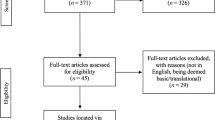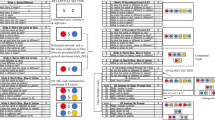Abstract
We review basic concepts and methods of stimulus equivalence research and suggest applications in teaching rudimentary language arts skills in the classroom. We describe methods of establishing equivalence-based networks of matching-to-sample, writing, and naming performances. The methods may be used as a supplement to classroom instruction to assess whether standard curriculum-based approaches establish such integrated networks. Methods derived from equivalence research may be useful for remediation when traditional teaching approaches fail. Recent research suggests that direct focus on spelling performances may be required if entire networks of language arts skills are to be acquired. In addition, the equivalence relations themselves may require concentrated teaching in some children.
Similar content being viewed by others
References
American Book Company. (1980).American readers: Finding places (Teacher's Edition). New York: Author.
Chomsky, C. (1971). Write first; read later.Child Education.47, 296–299.
D. C. Heath and Company. (1991).Heath reading: Preprimer 1 (Teacher's Edition). Lexington, MA: Author.
Devany, J. M., Hayes, S. C., & Nelson, R. O. (1986). Equivalence class formation in language-able and language-disabled children.Journal of the Experimental Analysis of Behavior, 46, 243–257.
Dube, W. V., McDonald, S. J., McIlvane, W. J., & Mackay, H. A. (1991). Constructed response matching to sample and spelling instruction.Journal of Applied Behavior Analysis, 24, 305–317.
Dube, W. V., & McIlvane, W. J. (1989). Adapting a microcomputer for behavioral evaluation of mentally retarded individuals. In J. A. Mulick & R. F. Antonak (Eds.),Transitions in mental retardation (Vol 4, pp. 104–127). Norwood, NJ: Ablex.
Ehri, L. C. (1991). Development of the ability to read words. In R. Barr, M. L. Kamil, P. B. Mosenthal, & P. D. Pearson (Eds.),Handbook of reading research, Volume II (pp. 383–417). White Plains, NY: Longman.
Ehri, L. C., & Wilce, L. S. (1987). Does learning to spell help beginners learn to read words?Reading Research Quarterly, 22, 47–65.
Frith, U. (1985). Beneath the surface of developmental dyslexia. In K. E. Patterson, J. C. Marshall, & M. Coltheart (Eds.),Surface dyslexia (pp. 301–330). London: Erlbaum.
Gough, P. B. (1984). Word recognition. In P. D. Pearson, R. Barr, M. L. Kamil, & P. Mosenthal (Eds.),Handbook of reading research (pp. 225–253). New York: Longman.
Graham, S. (1983). Effective spelling instruction.Elementary School Journal, 83, 560 567.
Graham, S., & Voth, V. P. (1990). Spelling instruction: Making modifications for students with learning disabilities.Academic Therapy, 25, 447–457.
Green, G. (1990). Differences in development of visual and auditory-visual equivalence relations.American Journal on Mental Retardation, 95, 260–270.
Guess, D., & Baer, D. M. (1973). An analysis of individual differences in generalization between receptive and productive language in retarded children.Journal of Applied Behavior Analysis, 6, 311–329.
Heron, T. E., Okyere, B. A., & Miller, A. D. (1991). A taxonomy of approaches to teach spelling.Journal of Behavioral Education, 1, 117–130.
Kinney, P. G., Stevens, K. B., & Schuster, J. W. (1988). The effects of CAI and time delay: A systematic program for teaching spelling.Journal of Special Education Technology, 9, 61–72.
Lazar, R. M., Davis-Lang, D., & Sanchez, L. (1984). The formation of stimulus equivalences in children.Journal of the Experimental Analysis of Behavior, 41, 251–266.
Lee, V. L. (1981). Prepositional phrases spoken and heard.Journal of the Experimental Analysis of Behavior, 35, 227–242.
Lee, V. L., & Pegler, A. M. (1982). Effects on spelling of training children to read.Journal of the Experimental Analysis of Behavior, 37, 311–322.
Lee, V. L., & Sanderson, G. M. (1987). Some contingencies of spelling.Analysis of Verbal Behavior, 5, 1–13.
Mackay, H, A. (1991). Stimulus equivalence: Implications for the development of adaptive behavior. In R. Remington (Ed.),The challenge of severe mental handicap: An applied behaviour analytic approach, (pp. 235–259) London, England: John Wiley & Sons.
Mackay, H. A. (1985). Stimulus equivalence in rudimentary reading and spelling.Analysis and Intervention in Developmental Disabilities, 5, 373–387.
Mackay, H. A., & Sidman, M. (1984). Teaching new behavior via equivalence relations. In P. H. Brooks, R. Sperber, & C. MacCauley (Eds.),Learning and cognition in the mentally retarded (pp. 493–513). Hillsdale, NJ: Erlbaum.
Osborne, J. G., & Gatch, M. B. (1989). Stimulus equivalence and receptive reading by hearing-impaired preschool children.Language, Speech, and Hearing Services in Schools, 20, 63–75.
Remington, B., & Clark, S. (1983). Acquisition of expressive signing by autistic children: An evaluation of the relative effect of simultaneous communication and sign-alone training.Journal of Applied Behavior Analysis, 16, 315–327.
Sidman, M. (1971). Reading and auditory-visual equivalences.Journal of Speech and Hearing Research, 14, 5–13.
Sidman, M. (1986). Functional analysis of emergent verbal classes. In T. Thompson & M. D. Zeiler (Eds.),Analysis and integration of behavioral units (pp. 213–245). Hillsdale, NJ: Erlbaum.
Sidman, M., & Cresson, O., Jr. (1973). Reading and crossmodal transfer of stimulus equivalences in severe retardation.American Journal of Mental Deficiency, 77, 515–523.
Sidman, M., Kirk, B., & Willson-Morris, M. (1985). Six-member stimulus classes generated by conditional-discrimination procedures.Journal of the Experimental Analysis of Behavior, 43, 21–42.
Sidman, M., Willson-Morris, M., & Kirk, B. (1986). Matching-to-sample procedures and the development of equivalence relations.Analysis and Intervention in Developmental Disabilities, 6, 1–19.
Spradlin, J. E., Cotter, V. W., & Baxley, N. (1973). Establishing a conditional discrimination without direct training: A study of transfer with retarded adolescents.American Journal of Mental Deficiency, 77, 556–566.
Stevens, K. B., Blackhurst, A. E., & Slaton, D. B. (1991). Teaching memorized spelling with a microcomputer: Time delay and computer-assisted instruction.Journal of Applied Behavior Analysis, 24, 153–160.
Stromer, R. (1991). Stimulus equivalence: Implications for teaching. In W. Ishaq (Ed.),Human behavior in today's world (pp. 109–122). New York: Praeger.
Stromer, R., & Mackay, H. A. (1990). Arbitrary stimulus relations and delayed identity matching to complex samples.Experimental Analysis of Human Behavior Bulletin, 8, 22–25.
Stromer, R., & Mackay, H. A. (in press). Delayed constructed-response identity matching improves the spelling performances of students with mental retardation.Journal of Behavioral Education.
Stromer, R., & Mackay, H. A. (in press). Spelling and emergent picture-printed word relations established with delayed identity matching to complex samples.Journal of Applied Behavior Analysis.
Stromer, R., & Mackay, H. A. (in press). Delayed identity matching to complex samples: Teaching students with mental retardation spelling and the prerequisites for equivalence classes.Research in Developmental Disabilities.
Stromer, R., & Osborne, J. G. (1982). Control of adolescent's arbitrary matching-to-sample by positive and negative stimulus relations.Journal of the Experimental Analysis of Behavior, 37, 329–348.
Tierney, R. J.. & Shanahan, T. (1991). Research on the reading-writing relationship: Interactions, transactions, and outcomes. In R. Barr, M. L. Kamil, P. B. Mosenthal, & P. D. Pearson (Eds.),Handbook of reading research, Volume II (pp. 246–280). White Plains, NY: Longman.
VanBiervliet, A. (1977). Establishing words and objects as functionally equivalent through manual sign training.American Journal of Mental Deficiency, 82, 178–186.
Wulz, S. V., & Hollis, J. H. (1979). Application of manual signing to the development of reading skills. In R. L. Schiefelbusch & J. H. Hollis (Eds.),Language intervention from ape to child (pp. 465–489). Baltimore, MD: University Park Press.
Author information
Authors and Affiliations
Rights and permissions
About this article
Cite this article
Stromer, R., Mackay, H.A. & Stoddard, L.T. Classroom applications of stimulus equivalence technology. J Behav Educ 2, 225–256 (1992). https://doi.org/10.1007/BF00948817
Accepted:
Issue Date:
DOI: https://doi.org/10.1007/BF00948817




